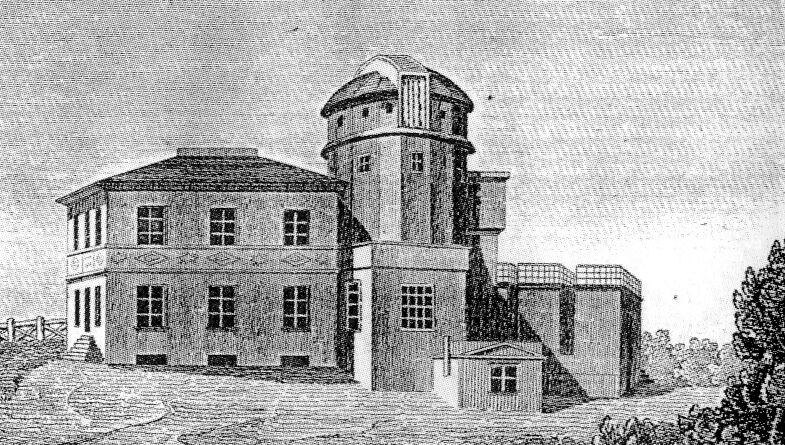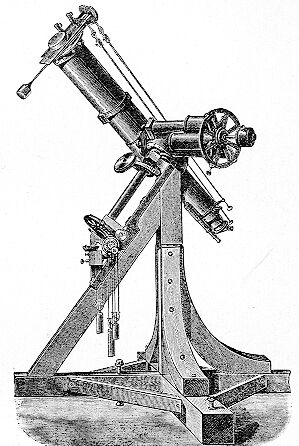|
Carl Theodor Anger
Carl Theodor Anger ( Danzig, 31 July 1803 – Danzig, 25 March 1858) was a German mathematician and astronomer. He was a student of and assistant to Friedrich Bessel at the Königsberg Observatory from 1827 until 1831. Thereafter, he was appointed as astronomer by the Naturforschende Gesellschaft in Danzig.Brandstäter (1858). Besides his scientific work, especially that related to Bessel function Bessel functions, first defined by the mathematician Daniel Bernoulli and then generalized by Friedrich Bessel, are canonical solutions of Bessel's differential equation x^2 \frac + x \frac + \left(x^2 - \alpha^2 \right)y = 0 for an arbitrary ...s, he is also known for his first-hand biographical notes on the life of Bessel. Publications * * * * See also * Anger function * Jacobi–Anger expansion Notes References * * * External links *ADB:Anger, Karl Theodor – Wikisource*Franz Kössler's Personlexikon von Lehren des 19. Jahrhunderts (Abbehusen – Axt); Anger, Kar ... [...More Info...] [...Related Items...] OR: [Wikipedia] [Google] [Baidu] |
Mathematician
A mathematician is someone who uses an extensive knowledge of mathematics in their work, typically to solve mathematical problems. Mathematicians are concerned with numbers, data, quantity, mathematical structure, structure, space, Mathematical model, models, and mathematics#Calculus and analysis, change. History One of the earliest known mathematicians were Thales of Miletus (c. 624–c.546 BC); he has been hailed as the first true mathematician and the first known individual to whom a mathematical discovery has been attributed. He is credited with the first use of deductive reasoning applied to geometry, by deriving four corollaries to Thales' Theorem. The number of known mathematicians grew when Pythagoras of Samos (c. 582–c. 507 BC) established the Pythagoreans, Pythagorean School, whose doctrine it was that mathematics ruled the universe and whose motto was "All is number". It was the Pythagoreans who coined the term "mathematics", and with whom the study of mathemat ... [...More Info...] [...Related Items...] OR: [Wikipedia] [Google] [Baidu] |
Astronomer
An astronomer is a scientist in the field of astronomy who focuses their studies on a specific question or field outside the scope of Earth. They observe astronomical objects such as stars, planets, moons, comets and galaxies – in either observational (by analyzing the data) or theoretical astronomy. Examples of topics or fields astronomers study include planetary science, solar astronomy, the origin or evolution of stars, or the formation of galaxies. A related but distinct subject is physical cosmology, which studies the Universe as a whole. Types Astronomers usually fall under either of two main types: observational and theoretical. Observational astronomers make direct observations of celestial objects and analyze the data. In contrast, theoretical astronomers create and investigate models of things that cannot be observed. Because it takes millions to billions of years for a system of stars or a galaxy to complete a life cycle, astronomers must observe snapsh ... [...More Info...] [...Related Items...] OR: [Wikipedia] [Google] [Baidu] |
Friedrich Bessel
Friedrich Wilhelm Bessel (; 22 July 1784 – 17 March 1846) was a German astronomer, mathematician, physicist, and geodesist. He was the first astronomer who determined reliable values for the distance from the sun to another star by the method of parallax. A special type of mathematical functions were named Bessel functions after Bessel's death, though they had originally been discovered by Daniel Bernoulli and then generalised by Bessel. Life and family Bessel was born in Minden, Westphalia, then capital of the Prussian administrative region Minden-Ravensberg, as second son of a civil servant into a large family. At the age of 14 Bessel was apprenticed to the import-export concern Kulenkamp at Bremen. The business's reliance on cargo ships led him to turn his mathematical skills to problems in navigation. This in turn led to an interest in astronomy as a way of determining longitude. Bessel came to the attention of a major figure of German astronomy at the time, ... [...More Info...] [...Related Items...] OR: [Wikipedia] [Google] [Baidu] |
Königsberg Observatory
Koenigsberg Observatory (german: Sternwarte Königsberg; Königsberger Universitätssternwarte; obs. code: 058) was an astronomical observatory and research facility which was attached to the Albertina University in Königsberg, what is now Kaliningrad, Russia. The observatory was destroyed by Royal Air Force bombs in August 1944 during the Second World War. Only the reduit (interior of the building) remained from the bastion. The building is a semicircular two-storey building with a brick vault. Nowadays, the building is considered a regional architectural monument. Description It was founded in 1810 and started working in 1813. Well-known astronomers who used the observatory included Friedrich Wilhelm Bessel, Friedrich Wilhelm Argelander, Arthur Auwers and Hermann Struve. In 1838, the parallax of a star was determined successfully for first time by Bessel using a heliometer A heliometer (from Greek ἥλιος ''hḗlios'' "sun" and ''measure'') is an instrument origin ... [...More Info...] [...Related Items...] OR: [Wikipedia] [Google] [Baidu] |
Danzig Research Society
The Naturforschende Gesellschaft in Danzig (translated Danzig Research Society, la, Societas Physicae Experimentalis, pl, Gdańskie Towarzystwo Przyrodnicze) was a scientific organization, founded in 1743 in Danzig (Gdańsk), Poland, which continued in existence until 1936. The ''Societas Physicae Experimentalis'' (Experimental Physics Society) was one of the oldest research societies in the Polish–Lithuanian Commonwealth and in Central and Eastern Europe. History Already in 1670, the physician Israel Conradi (1634–1715) had tried to organize a scientific society in the city, without success. Several others tried after him, until Daniel Gralath (1708–1767) finally succeeded. His father-in-law was Jacob Theodor Klein (1685–1759), a city secretary and also a very distinguished scientist, nicknamed ''Gedanensium Plinius''. At the end of 1742, Gralath had gathered a group of learned men for his purpose, an ''Experimental Physics Society'' (Societas Physicae Experimentali ... [...More Info...] [...Related Items...] OR: [Wikipedia] [Google] [Baidu] |
Bessel Function
Bessel functions, first defined by the mathematician Daniel Bernoulli and then generalized by Friedrich Bessel, are canonical solutions of Bessel's differential equation x^2 \frac + x \frac + \left(x^2 - \alpha^2 \right)y = 0 for an arbitrary complex number \alpha, the ''order'' of the Bessel function. Although \alpha and -\alpha produce the same differential equation, it is conventional to define different Bessel functions for these two values in such a way that the Bessel functions are mostly smooth functions of \alpha. The most important cases are when \alpha is an integer or half-integer. Bessel functions for integer \alpha are also known as cylinder functions or the cylindrical harmonics because they appear in the solution to Laplace's equation in cylindrical coordinates. #Spherical Bessel functions, Spherical Bessel functions with half-integer \alpha are obtained when the Helmholtz equation is solved in spherical coordinates. Applications of Bessel functions The Bessel f ... [...More Info...] [...Related Items...] OR: [Wikipedia] [Google] [Baidu] |
Anger Function
In mathematics, the Anger function, introduced by , is a function defined as : \mathbf_\nu(z)=\frac \int_0^\pi \cos (\nu\theta-z\sin\theta) \,d\theta and is closely related to Bessel functions. The Weber function (also known as Lommel–Weber function), introduced by , is a closely related function defined by : \mathbf_\nu(z)=\frac \int_0^\pi \sin (\nu\theta-z\sin\theta) \,d\theta and is closely related to Bessel functions of the second kind. Relation between Weber and Anger functions The Anger and Weber functions are related by : \begin \sin(\pi \nu)\mathbf_\nu(z) &= \cos(\pi\nu)\mathbf_\nu(z)-\mathbf_(z), \\ -\sin(\pi \nu)\mathbf_\nu(z) &= \cos(\pi\nu)\mathbf_\nu(z)-\mathbf_(z), \end so in particular if ν is not an integer they can be expressed as linear combinations of each other. If ν is an integer then Anger functions Jν are the same as Bessel functions ''J''ν, and Weber functions can be expressed as finite linear combinations of Struve functions. Power series ... [...More Info...] [...Related Items...] OR: [Wikipedia] [Google] [Baidu] |
Jacobi–Anger Expansion
In mathematics, the Jacobi–Anger expansion (or Jacobi–Anger identity) is an expansion of exponentials of trigonometric functions in the basis of their harmonics. It is useful in physics (for example, to convert between plane waves and cylindrical waves), and in signal processing (to describe FM signals). This identity is named after the 19th-century mathematicians Carl Jacobi and Carl Theodor Anger. The most general identity is given by:Colton & Kress (1998) p. 32.Cuyt ''et al.'' (2008) p. 344. : e^ \equiv \sum_^ i^n\, J_n(z)\, e^, where J_n(z) is the n-th Bessel function of the first kind and i is the imaginary unit, i^2=-1. Substituting \theta by \theta-\frac, we also get: : e^ \equiv \sum_^ J_n(z)\, e^. Using the relation J_(z) = (-1)^n\, J_(z), valid for integer n, the expansion becomes: :e^ \equiv J_0(z)\, +\, 2\, \sum_^\, i^n\, J_n(z)\, \cos\, (n \theta). Real-valued expressions The following real-valued variations are often useful as well:Abramowitz ... [...More Info...] [...Related Items...] OR: [Wikipedia] [Google] [Baidu] |
1803 Births
Eighteen or 18 may refer to: * 18 (number), the natural number following 17 and preceding 19 * one of the years 18 BC, AD 18, 1918, 2018 Film, television and entertainment * ''18'' (film), a 1993 Taiwanese experimental film based on the short story ''God's Dice'' * ''Eighteen'' (film), a 2005 Canadian dramatic feature film * 18 (British Board of Film Classification), a film rating in the United Kingdom, also used in Ireland by the Irish Film Classification Office * 18 (''Dragon Ball''), a character in the ''Dragon Ball'' franchise * "Eighteen", a 2006 episode of the animated television series '' 12 oz. Mouse'' Music Albums * ''18'' (Moby album), 2002 * ''18'' (Nana Kitade album), 2005 * '' 18...'', 2009 debut album by G.E.M. Songs * "18" (5 Seconds of Summer song), from their 2014 eponymous debut album * "18" (One Direction song), from their 2014 studio album ''Four'' * "18", by Anarbor from their 2013 studio album ''Burnout'' * "I'm Eighteen", by Alice Cooper comm ... [...More Info...] [...Related Items...] OR: [Wikipedia] [Google] [Baidu] |
1858 Deaths
Events January–March * January – ** Benito Juárez (1806–1872) becomes Liberal President of Mexico. At the same time, conservatives install Félix María Zuloaga (1813–1898) as president. ** William I of Prussia becomes regent for his brother, Frederick William IV, who had suffered a stroke. * January 9 ** British forces finally defeat Rajab Ali Khan of Chittagong ** Anson Jones, the last president of the Republic of Texas, commits suicide. * January 14 – Orsini affair: Felice Orsini and his accomplices fail to assassinate Napoleon III in Paris, but their bombs kill eight and wound 142 people. Because of the involvement of French émigrés living in Britain, there is a brief anti-British feeling in France, but the emperor refuses to support it. * January 25 – The '' Wedding March'' by Felix Mendelssohn becomes a popular wedding recessional, after it is played on this day at the marriage of Queen Victoria's daughter Victoria, Princess Roy ... [...More Info...] [...Related Items...] OR: [Wikipedia] [Google] [Baidu] |
19th-century German Mathematicians
The 19th (nineteenth) century began on 1 January 1801 ( MDCCCI), and ended on 31 December 1900 ( MCM). The 19th century was the ninth century of the 2nd millennium. The 19th century was characterized by vast social upheaval. Slavery was abolished in much of Europe and the Americas. The First Industrial Revolution, though it began in the late 18th century, expanding beyond its British homeland for the first time during this century, particularly remaking the economies and societies of the Low Countries, the Rhineland, Northern Italy, and the Northeastern United States. A few decades later, the Second Industrial Revolution led to ever more massive urbanization and much higher levels of productivity, profit, and prosperity, a pattern that continued into the 20th century. The Islamic gunpowder empires fell into decline and European imperialism brought much of South Asia, Southeast Asia, and almost all of Africa under colonial rule. It was also marked by the collapse of the la ... [...More Info...] [...Related Items...] OR: [Wikipedia] [Google] [Baidu] |






